A UAV-Based System for Validating a Backward Lagrangian Stochastic Model in a Dairy Cattle Farm
Abstract
1. Introduction
2. Materials and Methods
2.1. Animals and Housing
2.2. Multi-Sensor Platforms
2.3. Experimental Setup and Data Analysis
WindTrax Model Assumptions and Inputs
3. Results and Discussion
3.1. CO2 Emission Fluxes
3.2. CO2 Concentrations
3.3. Limitations
4. Conclusions
Supplementary Materials
Author Contributions
Funding
Institutional Review Board Statement
Informed Consent Statement
Data Availability Statement
Acknowledgments
Conflicts of Interest
References
- United Nations. World Population Prospects 2024: Summary of Results; DESA/POP/2024/TR/NO. 9; UN Department of Economic and Social Affairs: New York, NY, USA, 2024. [Google Scholar]
- The 17 Goals. Available online: https://sdgs.un.org/goals (accessed on 20 May 2025).
- Ambient (Outdoor) Air Pollution. Available online: https://www.who.int/news-room/fact-sheets/detail/ambient-(outdoor)-air-quality-and-health (accessed on 20 May 2025).
- Shukla, P.R.; Skea, J.; Reisinger, A.; Slade, R.; Fradera, R.; Pathak, M.; Al Khourdajie, A.; Belkacemi, M.; Van Diemen, R.; Hasija, A.; et al. Summary for Policymakers. In Climate Change 2022—Mitigation of Climate Change: Working Group III Contribution to the Sixth Assessment Report of the Intergovernmental Panel on Climate Change; Cambridge University Press: Cambridge, UK, 2023. [Google Scholar] [CrossRef]
- FAO. GLEAM 3 Dashboard. In Shiny Apps; 2022; Available online: https://foodandagricultureorganization.shinyapps.io/GLEAMV3_Public/ (accessed on 20 May 2025).
- Chang, C.-C.; Wang, J.-L.; Chang, C.-Y.; Liang, M.-C.; Lin, M.-R. Development of a multicopter-carried whole air sampling apparatus and its applications in environmental studies. Chemosphere 2016, 144, 484–492. [Google Scholar] [CrossRef]
- Samad, A.; Florez, D.A.; Chourdakis, I.; Vogt, U. Concept of Using an Unmanned Aerial Vehicle (UAV) for 3D Investigation of Air Quality in the Atmosphere-Example of Measurements Near a Roadside. Atmosphere 2022, 13, 663. [Google Scholar] [CrossRef]
- Baglioli, F.; Godoi, R.H. Sniffing Drones: A Promising Solution for Measuring Railroad Emissions in Urban Environments. Atmosphere 2023, 14, 865. [Google Scholar] [CrossRef]
- Kemp, E.C.; Ravikumar, A.P.; Brandt, A.R. Comparing Natural Gas Leakage Detection Technologies Using an Open-Source “Virtual Gas Field” Simulator. Environ. Sci. Technol. 2016, 50, 4546–4553. [Google Scholar] [CrossRef]
- Faksness, L.-G.; Leirvik, F.; Taban, I.C.; Engen, F.; Jensen, H.V.; Holbu, J.W.; Dolva, H.; Bråtveit, M. Offshore field experiments with in-situ burning of oil: Emissions and burn efficiency. Environ. Res. 2022, 205, 112419. [Google Scholar] [CrossRef] [PubMed]
- O’Malley, D.; Delorey, A.A.; Guiltinan, E.J.; Ma, Z.; Kadeethum, T.; Lackey, G.; Lee, J.; Santos, J.E.; Follansbee, E.; Nair, M.C.; et al. Unlocking Solutions: Innovative Approaches to Identifying and Mitigating the Environmental Impacts of Undocumented Orphan Wells in the United States. Environ. Sci. Technol. 2024, 58, 19584–19594. [Google Scholar] [CrossRef] [PubMed]
- Kuuluvainen, H.; Poikkimäki, M.; Järvinen, A.; Kuula, J.; Irjala, M.; Dal Maso, M.; Keskinen, J.; Timonen, H.; Niemi, J.V.; Rönkkö, T. Vertical profiles of lung deposited surface area concentration of particulate matter measured with a drone in a street canyon. Environ. Pollut. 2018, 241, 96–105. [Google Scholar] [CrossRef]
- Beryozkina, S.; Al-Shakhs, N. Real-life Application of the Emission Monitoring System by Using a Drone. In Proceedings of the 2020 IEEE International Conference on Environment and Electrical Engineering and 2020 IEEE Industrial and Commercial Power Systems Europe (EEEIC/I&CPS Europe), Madrid, Spain, 9–12 June 2020. [Google Scholar] [CrossRef]
- Lee, S.-H.; Kwak, K.-H. Assessing 3-D Spatial Extent of Near-Road Air Pollution around a Signalized Intersection Using Drone Monitoring and WRF-CFD Modeling. Int. J. Environ. Res. Public Health 2020, 17, 6915. [Google Scholar] [CrossRef]
- Klimczyk, M. The Concept of a Collection System for Gas Mixture from the Interior of Chimney Openings for Unmanned Flying Systems. Adv. Sci. Technol. 2021, 15, 191–196. [Google Scholar] [CrossRef]
- Chang, C.-Y.; Wang, J.-L.; Chen, Y.-C.; Pan, X.-X.; Chen, W.-N.; Lin, M.-R.; Ho, Y.-J.; Chuang, M.-T.; Liu, W.-T.; Chang, C.-C. A study of the vertical homogeneity of trace gases in East Asian continental outflow. Chemosphere 2022, 297, 134165. [Google Scholar] [CrossRef]
- Järvi, L.; Kuruppa, M.; Kuuluvainen, H.; Rönkkö, T.; Karttunen, S.; Balling, A.; Timonen, H.; Niemi, J.V.; Pirjola, L. Determinants of spatial variability of air pollutant concentrations in a street canyon network measured using a mobile laboratory and a drone. Sci. Total Environ. 2023, 856, 158974. [Google Scholar] [CrossRef]
- Durgun, Y.; Durgun, M. Smart environmental drone utilization for monitoring urban air quality. Environ. Res. Technol. 2024, 7, 194–200. [Google Scholar] [CrossRef]
- Lee, S.; Park, J.; Baek, M.; Kim, M.; Yoo, M.; Kwon, Y.; Lee, H. An integrated drone-based platform with novel correction methods for accurate vertical profiling of black carbon. Atmos. Environ. 2025, 349, 121147. [Google Scholar] [CrossRef]
- Burgués, J.; Doñate, S.; Esclapez, M.D.; Saúco, L.; Marco, S. Characterization of odour emissions in a wastewater treatment plant using a drone-based chemical sensor system. Sci. Total Environ. 2022, 846, 157290. [Google Scholar] [CrossRef] [PubMed]
- Angrisani, L.; Amodio, A.; Arpaia, P.; Asciolla, M.; Bellizzi, A.; Bonavolontà, F.; Carbone, R.; Caputo, E.; Karamanolis, G.; Martire, V.; et al. An Innovative Air Quality Monitoring System based on Drone and IoT Enabling Technologies. In Proceedings of the 2019 IEEE International Workshop on Metrology for Agriculture and Forestry (MetroAgriFor), Portici, Italy, 24–26 October 2019. [Google Scholar] [CrossRef]
- Morales, R.; Ravelid, J.; Vinkovic, K.; Korbeń, P.; Tuzson, B.; Emmenegger, L.; Chen, H.; Schmidt, M.; Humbel, S.; Brunner, D. Controlled-release experiment to investigate uncertainties in UAV-based emission quantification for methane point sources. Atmos. Meas. Tech. 2022, 15, 2177–2198. [Google Scholar] [CrossRef]
- Zhao, T.; Yang, D.; Liu, Y.; Cai, Z.; Yao, L.; Che, K.; Ren, X.; Bi, Y.; Yi, Y.; Wang, J.; et al. Development of an Integrated Lightweight Multi-Rotor UAV Payload for Atmospheric Carbon Dioxide Mole Fraction Measurements. Atmosphere 2022, 13, 855. [Google Scholar] [CrossRef]
- Afshar-Mohajer, N.; Wu, C.-Y. Use of a drone-based sensor as a field-ready technique for short-term concentration mapping of air pollutants: A modeling study. Atmos. Environ. 2023, 294, 119476. [Google Scholar] [CrossRef]
- Tiwari, G.; Lall, B. Low-Cost Sensors Based PM Profiling Using Aerial Platform. In Proceedings of the 2023 IEEE 11th Region 10 Humanitarian Technology Conference (R10-HTC), Rajkot, India, 16–18 October 2023. [Google Scholar] [CrossRef]
- Bernabeo, A.R.; D’Alessandro, G.; Ceruti, A.; Tositti, L.; Nguyen, N.; Ho, T.P. Air quality monitoring using drones (UAV). In Proceedings of the International Conference on Sustainable Energy and Green Technology 2023, Ho Chi Minh City, Vietnam, 10–13 December 2023. [Google Scholar] [CrossRef]
- Ranganathan, R.H.; Balusamy, S.; Partheeban, P.; Mani, C.; Sridhar, M.; Rajasekaran, V. Air Quality Monitoring and Analysis for Sustainable Development of Solid Waste Dump Yards Using Smart Drones and Geospatial Technology. Sustainability 2023, 15, 13347. [Google Scholar] [CrossRef]
- Tosato, P.; Facinelli, D.; Prada, M.; Gemma, L.; Rossi, M.; Brunelli, D. An autonomous swarm of drones for industrial gas sensing applications. In Proceedings of the 2019 IEEE 20th International Symposium on “A World of Wireless, Mobile and Multimedia Networks” (WoWMoM), Washinton, DC, USA, 10–12 June 2019. [Google Scholar] [CrossRef]
- Aurell, J.; Gullet, B.K.; Holder, A.L.; Kiros, F.; Mitchell, W.A.; Watts, A.C.; Ottmar, R.D. Wildland fire emission sampling at Fishlake National Forest, Utah using an unmanned aircraft system. Atmos. Environ. 2021, 247, 118193. [Google Scholar] [CrossRef]
- Rüdiger, J.; Tirpitz, J.-L.; de Moor, M.J.; Bobrowski, N.; Gutmann, A.; Liuzzo, M.; Ibarra, M.; Hoffmann, T. Implementation of electrochemical, optical and denuder-based sensors and sampling techniques on UAV for volcanic gas measurements: Examples from Masaya, Turrialba and Stromboli volcanoes. Atmos. Meas. Tech. 2018, 11, 2441–2457. [Google Scholar] [CrossRef]
- Liu, E.J.; Wood, K.; Mason, E.; Edmonds, E.; Aiuppa, A.; Giudice, G.; Bitetto, M.; Francoforte, V.; Burrow, S.; Richardson, T.; et al. Dynamics of Outgassing and Plume Transport Revealed by Proximal Unmanned Aerial System (UAS) Measurements at Volcán Villarrica, Chile. Geochem. Geophys. Geosys. 2019, 20, 730–750. [Google Scholar] [CrossRef]
- Habib, M.R.; Baticados, E.N.; Capareda, S.C. Particulate Matter Emission Factors for Dairy Facilities and Cattle Feedlots during Summertime in Texas. Int. J. Environ. Res. Public Health 2022, 19, 14090. [Google Scholar] [CrossRef] [PubMed]
- Velez, A.F.; Alvarez, C.I.; Navarro, F.; Guzman, D.; Bohorquez, M.P.; Gomez Selvaraj, M.; Ishitani, M. Assessing methane emissions from paddy fields through environmental and UAV remote sensing variables. Environ. Monit. Assess. 2024, 196, 574. [Google Scholar] [CrossRef]
- Roldán, J.J.; Joossen, G.; Sanz, D.; del Cerro, J.; Barrientos, A. Mini-UAV Based Sensory System for Measuring Environmental Variables in Greenhouses. Sensors 2015, 15, 3334–3350. [Google Scholar] [CrossRef]
- Zheng, Y.; Yang, S.; Liu, X.; Wang, J.; Norton, T.; Chen, J.; Tan, Y. The computational fluid dynamic modeling of downwash flow field for a six-rotor UAV. Front. Agric. Sci. Eng. 2018, 5, 159–167. [Google Scholar] [CrossRef]
- Flem, A.A.; Ghirardelli, M.; Kral, S.T.; Cheynet, E.; Kristensen, T.O.; Reuder, J. Experimental Characterization of Propeller-Induced Flow (PIF) below a Multi-Rotor UAV. Atmosphere 2024, 15, 242. [Google Scholar] [CrossRef]
- Altamira-Colado, E.; Cuevas-González, D.; Reyna, M.A.; García-Vázquez, J.P.; Avitia, R.L.; Osornio-Vargas, A.R. Drone-Assisted Particulate Matter Measurement in Air Monitoring: A Patent Review. Atmosphere 2024, 15, 515. [Google Scholar] [CrossRef]
- Jońca, J.; Pawnuk, M.; Bezyk, Y.; Arsen, A.; Sówka, I. Drone-Assisted Monitoring of Atmospheric Pollution-A Comprehensive Review. Sustainability 2022, 14, 11516. [Google Scholar] [CrossRef]
- Kim, W.Y.; Lee, S.G.; Lee, H.; Ahn, K.-H. Investigation of Vertical Profiles of Particulate Matter and Meteorological Variables up to 2.5 km in Altitude Using a Drone-Based Monitoring System. Atmosphere 2025, 16, 93. [Google Scholar] [CrossRef]
- Flesch, T.K.; Wilson, J.D. Estimating Tracer Emissions with a Backward Lagrangian Stochastic Technique. In Micrometeorology in Agricultural Systems; Hatfield, J.L., Baker, J.M., Eds.; American Society of Agronomy, Crop Science Society of America, Soil Science Society of America: Madison, WI, USA, 2005; Volume 47, pp. 513–531. [Google Scholar] [CrossRef]
- Flesch, T.K.; Wilson, J.D.; Yee, E. Backward-Time Lagrangian Stochastic Dispersion Models and Their Application to Estimate Gaseous Emissions. J. Appl. Meteorol. Climatol. 1995, 34, 1320–1322. [Google Scholar] [CrossRef]
- Crenna, B.P. WindTrax, v2.0.9.7 [Software]. 2020. Available online: http://www.thunderbeachscientific.com/ (accessed on 20 May 2025).
- Bai, M.; Suter, H.; Lam, S.; Sun, J.; Chen, D. Use of open-path FTIR and inverse dispersion technique to quantify gaseous nitrogen loss from an intensive vegetable production site. Atmos. Environ. 2014, 94, 687–691. [Google Scholar] [CrossRef]
- Lavrsen Kure, J.; Krabben, J.; Pedersen, S.V.; Carozzi, M.; Sommer, S.G. An Assessment of Low-Cost Techniques to Measure Ammonia Emission from Multi-Plots: A Case Study with Urea Fertilization. Agronomy 2018, 8, 245. [Google Scholar] [CrossRef]
- Righi Ricco, C.; Finzi, A.; Guido, V.; Riva, E.; Ferrari, O.; Provolo, G. Evaluation of ammonia emissions from filtration of digestate used for fertigation. J. Agric. Eng. 2021, 52, 1187. [Google Scholar] [CrossRef]
- Angelino, E.; Malvestiti, G.; Marongiu, A.; Fossati, G.; Peroni, E. Applicazione della modellistica inversa per la stima del flusso emissivo di ammoniaca in ambito zootecnico. Ing. dell’Ambiente 2022, 9, 1. [Google Scholar] [CrossRef]
- Bell, M.W.; Tang, Y.S.; Dragosits, U.; Fléchard, C.R.; Ward, P.; Braban, C.F. Ammonia emissions from an anaerobic digestion plant estimated using atmospheric measurements and dispersion modelling. Waste Manag. 2016, 56, 113–124. [Google Scholar] [CrossRef] [PubMed]
- Hrad, M.; Vesenmaier, A.; Flandorfer, C.; Piringer, M.; Stenzel, S.; Huber-Humer, M. Comparison of forward and backward Lagrangian transport modelling to determine methane emissions from anaerobic digestion facilities. Atmos. Environ. X 2021, 12, 100131. [Google Scholar] [CrossRef]
- Leytem, A.B.; Bjorneberg, D.L.; Rotz, C.A.; Moraes, L.E.; Kebreab, E.; Dungan, R.S. Ammonia Emissions from Dairy Lagoons in the Western U.S. Trans. ASABE 2018, 61, 1001–1015. [Google Scholar] [CrossRef]
- Shonkwiler, K.B.; Ham, J.M. Ammonia emissions from a beef feedlot: Comparison of inverse modeling techniques using long-path and point measurements of fenceline NH3. Agric. For. Meteorol. 2018, 258, 29–42. [Google Scholar] [CrossRef]
- Genedy, R.; Ogejo, J. Estimating ammonia emitted from manure during storage on a dairy farm. In Proceedings of the 2022 ASABE Annual International Meeting, Houston, TX, USA, 17–20 July 2022. [Google Scholar] [CrossRef]
- Tagliaferri, F.; Invernizzi, M.; Capra, F.; Sironi, S. Validation study of WindTrax reverse dispersion model coupled with a sensitivity analysis of model-specific settings. Environ. Res. 2023, 222, 115401. [Google Scholar] [CrossRef]
- Pedone, M.; Granieri, D.; Moretti, R.; Fedele, A.; Troise, C.; Somma, R.; De Natale, G. Improved quantification of CO2 emission at Campi Flegrei by combined Lagrangian Stochastic and Eulerian dispersion modelling. Atmos. Environ. 2017, 170, 1–11. [Google Scholar] [CrossRef]
- Sauer, U.; Borsdorf, H.; Dietrich, B.; Liebscher, A.; Möller, I.; Martens, S.; Möller, F.; Schlömer, S.; Schütze, C. Application of open-path Fourier transform infrared spectroscopy for atmospheric monitoring of a CO2 back-production experiment at the Ketzin pilot site (Germany). Environ. Monit. Assess. 2018, 190, 114. [Google Scholar] [CrossRef]
- Crenna, B.P. WindTrax Introductory Manual. 2006. Available online: http://thunderbeachscientific.com/downloads/introduction.pdf (accessed on 20 May 2025).
- Leso, L.; Barbari, M.; Lopes, M.A.; Damasceno, F.A.; Galama, P.J.; Taraba, J.L.; Kuipers, A. Invited review: Compost-bedded pack barns for dairy cows. J. Dairy Sci. 2020, 103, 1072–1099. [Google Scholar] [CrossRef]
- El Mashad, H.M.; Barzee, T.J.; Franco, R.B.; Zhang, R.; Kaffka, S.; Mitloehner, F. Anaerobic Digestion and Alternative Manure Management Technologies for Methane Emissions Mitigation on Californian Dairies. Atmosphere 2023, 14, 120. [Google Scholar] [CrossRef]
- Wolf, K. A Portable Sensor for Measuring Gas Emissions from Dairy Compost Bedded Pack Barns. Master’s Thesis, University of Kentucky, Lexington, KY, USA, 27 July 2017. [Google Scholar] [CrossRef]
- Ayadi, F.; Cortus, E.; Spiehs, M.; Miller, D.; Djira, G. Ammonia and Greenhouse Gas Concentrations at Surfaces of Simulated Beef Cattle Bedded Manure Packs. Trans. ASABE 2015, 58, 783–795. [Google Scholar] [CrossRef]
- Fuertes, E.; Balcells, J.; Maynegre, J.; de la Fuente, G.; Sarri, L.; Seradj, A.R. Measurement of Methane and Ammonia Emissions from Compost-Bedded Pack Systems in Dairy Barns: Tilling Effect and Seasonal Variations. Animals 2023, 13, 1871. [Google Scholar] [CrossRef]
- Ferreira, J.C.; Ferraz, P.F.; Ferraz, G.A.; de Oliveira, F.M.; Cadavid, V.; Rossi, G.; Becciolini, V. Spatial variability of methane and carbon dioxide gases in a Compost-Bedded Pack Barn system. Agron. Res. 2024, 22, 110–126. [Google Scholar] [CrossRef]
- 3D Flow srl. 3DF Zephyr, v7.5 [Software]. 2023. Available online: https://www.3dflow.net/it/software-di-fotogrammetria-3df-zephyr/ (accessed on 20 May 2025).
- QGIS Association. QGIS Geographic Information System, v3.22.5 [Software]. 2023. Available online: https://www.qgis.org/ (accessed on 20 May 2025).
- Mattia, A.; Merlini, M.; Squillace, F.; Rossi, G.; Conti, L.; Becciolini, V. Assessment of CO2 emission rate from extended area sources with WindTrax model in a dairy cattle farm. Agron. Res. 2025, 23, 1–15. [Google Scholar] [CrossRef]
- Becciolini, V.; Conti, L.; Bedin Marin, D.; Merlini, M.; Coletti, G.; Rossi, U.; Barbari, M. Real-Time Measurements of Gaseous and Particulate Emissions from Livestock Buildings and Manure Stores with Novel UAV-Based System. In Proceedings of the AIIA 2022: Biosystems Engineering Towards the Green Deal, Palermo, Italy, 19–22 September 2022. [Google Scholar] [CrossRef]
- Becciolini, V.; Merlini, M.; Massera, E.; Bedin Marin, D.; Rossi, G.; Barbari, M. Performance of a Multi-sensor System for Ground and Aerial Sampling of Pollutants in Livestock Farms. In Proceedings of the AIIA 2024—Mid-Term Conference, Padova, Italy, 17–19 June 2024. [Google Scholar] [CrossRef]
- Crenna, B.P. Atmospheric Data in WindTrax. 2006. Available online: http://www.thunderbeachscientific.com/downloads/atmosphericdata.pdf (accessed on 20 May 2025).
- Crenna, B.P.; Flesch, T.K.; Wilson, J.D. Influence of source–sensor geometry on multi-source emission rate estimates. Atmos. Environ. 2008, 42, 7373–7383. [Google Scholar] [CrossRef]
- Mattia, A.; Becciolini, V.; Rossi, G.; Conti, L.; Merlini, M.; Ferraz, P.F.P.; Ferraz, G.A.S.; Ferreira, J.C.; de Oliveira, F.M. Proposal of a methodology for quantifying carbon dioxide emissions by customized multi-sensor platforms in a dairy cattle farm: Tilling effect of a compost bedded pack barn. Atmos. Pollut. Res. 2025, submitted.
- R Core Team. R: A Language and Environment for Statistical Computing; R Foundation for Statistical Computing: Vienna, Austria, 2024; Available online: https://www.R-project.org/ (accessed on 20 May 2025).
- RStudio Team. RStudio: Integrated Development for R; RStudio, Inc.: Boston, MA, USA, 2024; Available online: http://www.rstudio.com/ (accessed on 20 May 2025).
- Carslaw, D.C.; Ropkins, K. openair—An R package for air quality data analysis. Environ. Model. Softw. 2012, 27–28, 52–61. [Google Scholar] [CrossRef]
- Carslaw, D.C. The Openair Manual—Open-Source Tools for Analysing Air Pollution Data; University of York: New York, NY, USA, 2019; Available online: https://openair-project.github.io/book/ (accessed on 20 May 2025).
- Hijmans, R. raster: Geographic Data Analysis and Modeling. R Package, v3.6-30. 2024. Available online: https://rspatial.org/raster/ (accessed on 20 May 2025).
- Wei, T.; Simko, V. R Package ‘corrplot’: Visualization of a Correlation Matrix. 2024. Available online: https://github.com/taiyun/corrplot (accessed on 20 May 2025).
- Wickham, H. ggplot2: Elegant Graphics for Data Analysis. 2016. Available online: https://ggplot2.tidyverse.org/ (accessed on 20 May 2025).
- Elpelt-Wessel, I.; Reiser, M.; Morrison, D.; Kranert, M. Emission Determination by Three Remote Sensing Methods in Two Release Trials. Atmosphere 2022, 13, 53. [Google Scholar] [CrossRef]
- Riddick, S.N.; Ancona, R.; Cheptonui, F.; Bell, C.S.; Duggan, A.; Bennett, K.E.; Zimmerle, D.J. A cautionary report of calculating methane emissions using low-cost fence-line sensors. Elem. Sci. Anthr. 2022, 10, 00021. [Google Scholar] [CrossRef]
- Shaw, J.T.; Allen, G.; Pitt, J.; Shah, A.; Wilde, S.; Stamford, L.; Fan, Z.; Ricketts, H.; Williams, P.I.; Bateson, P.; et al. Methane flux from flowback operations at a shale gas site. J. Air Waste Manag. Assoc. 2020, 7, 1324–1339. [Google Scholar] [CrossRef] [PubMed]
- Tian, S.; Smits, K.M.; Cho, Y.; Riddick, S.N.; Zimmerle, D.J.; Duggan, A. Estimating methane emissions from underground natural gas pipelines using an atmospheric dispersion-based method. Elem. Sci. Anthr. 2022, 10, 00045. [Google Scholar] [CrossRef]
- Billesbach, D.; Arkebauer, T.; Sullivan, R. Intercomparison of sensible and latent heat flux measurements from combined eddy covariance, energy balance, and Bowen ratio methods above a grassland prairie. Sci. Rep. 2024, 14, 21866. [Google Scholar] [CrossRef]

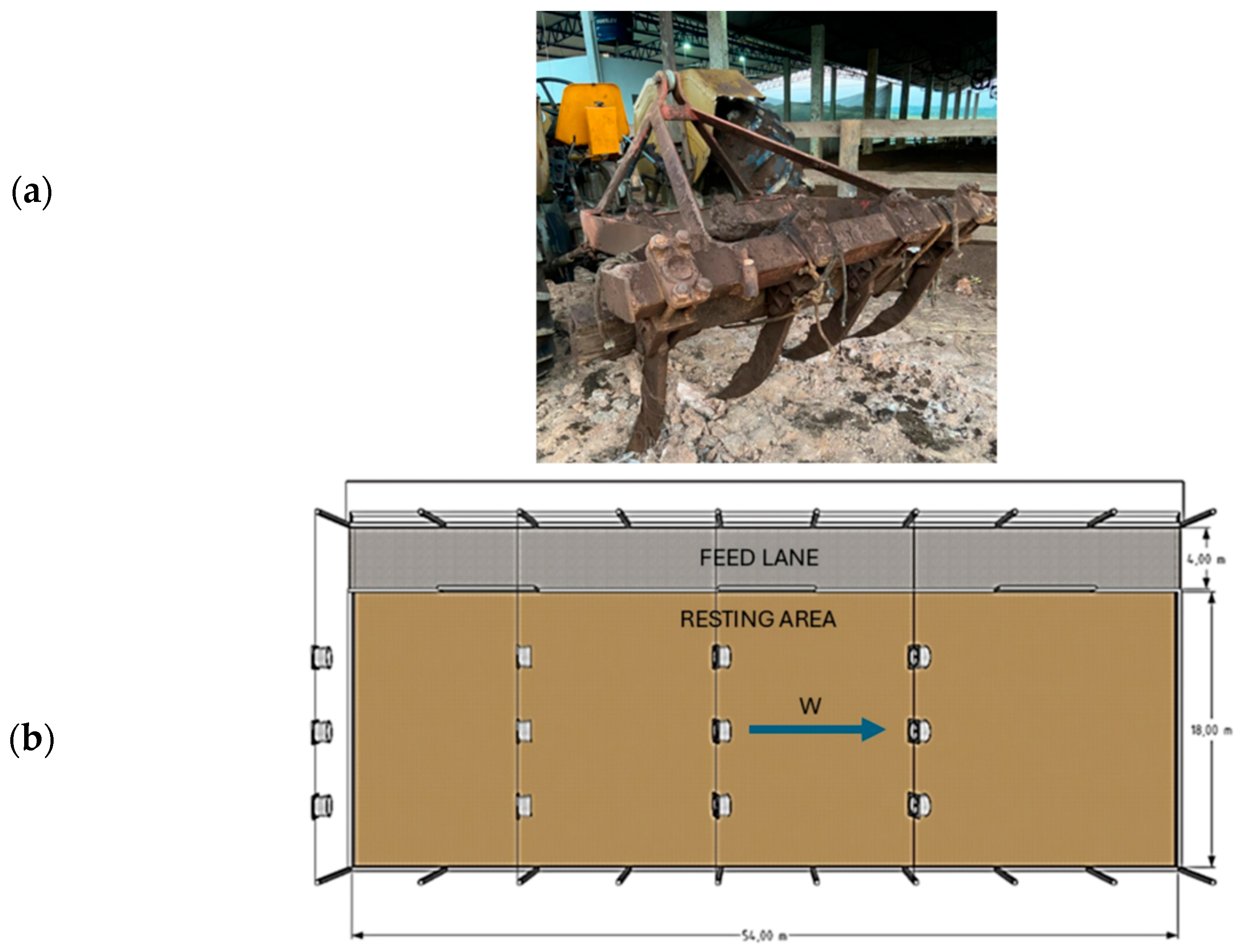
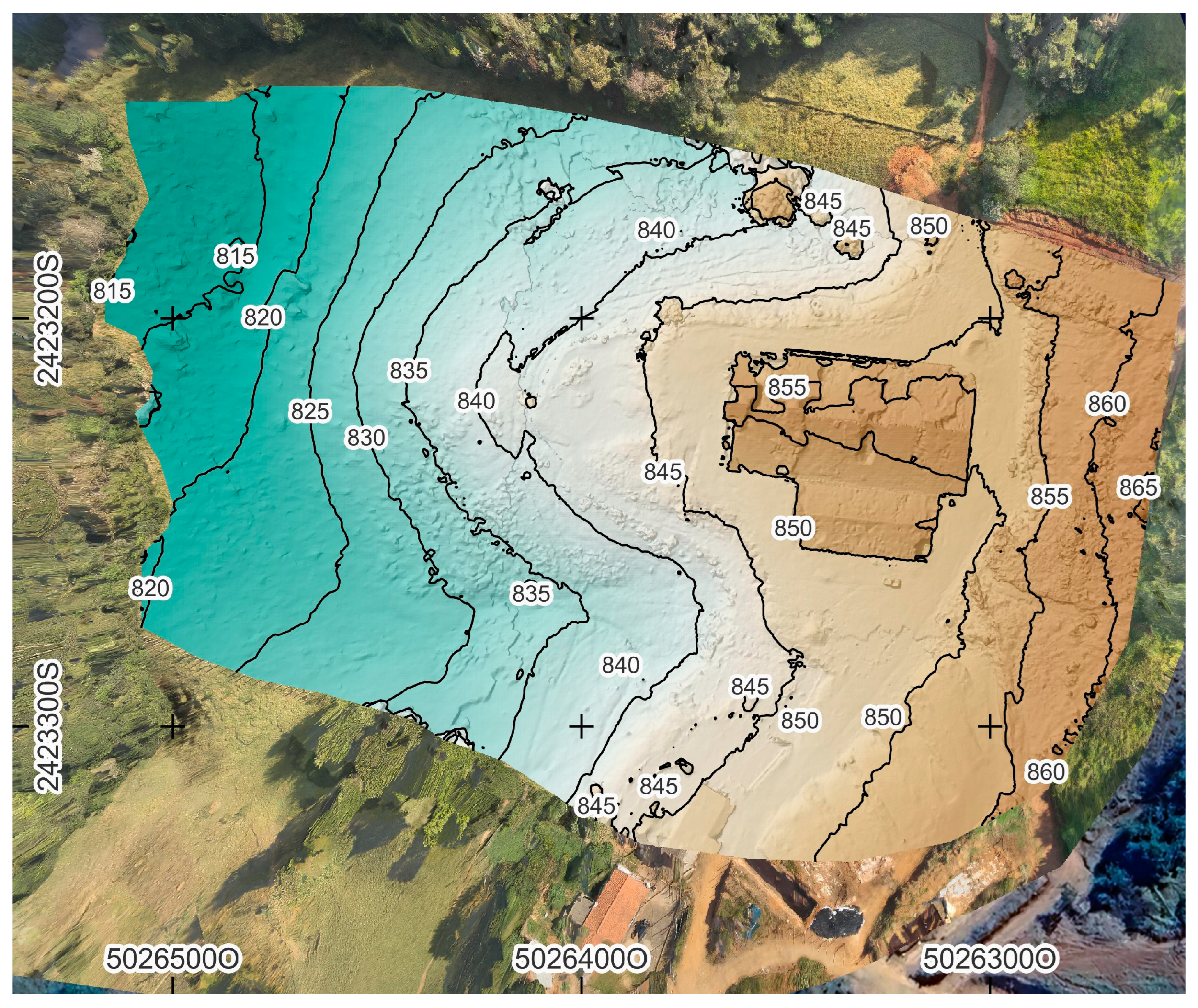

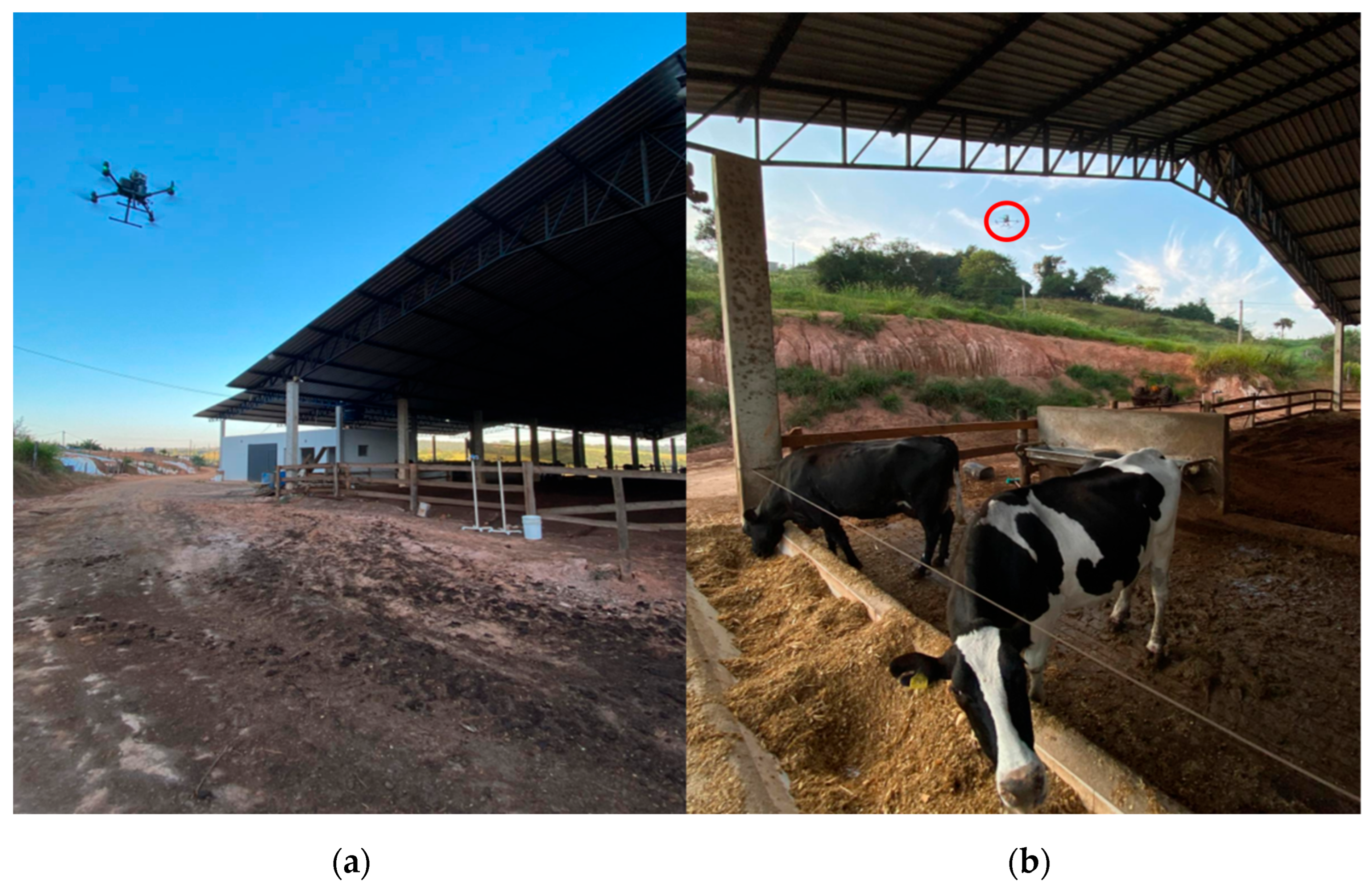


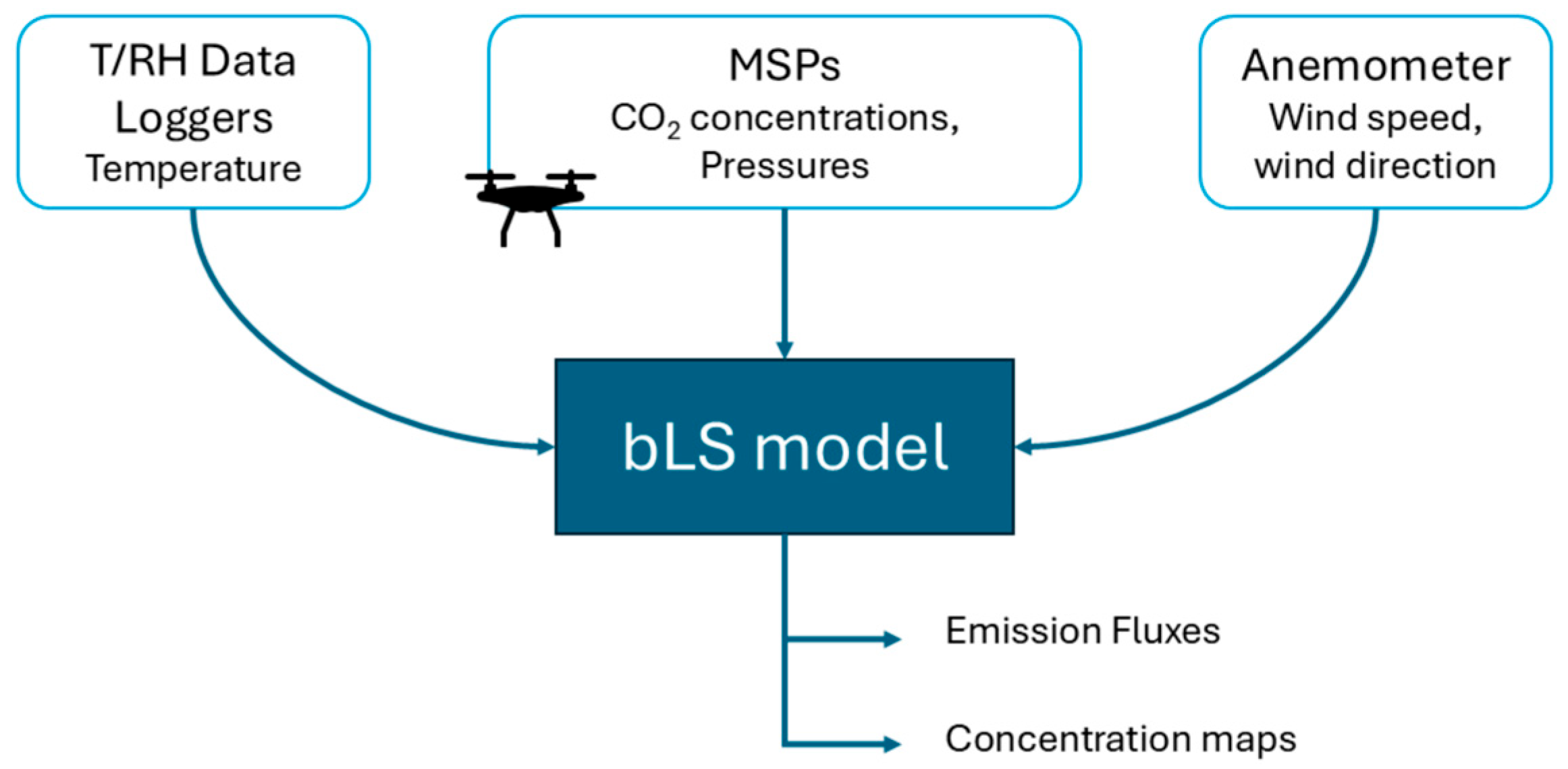



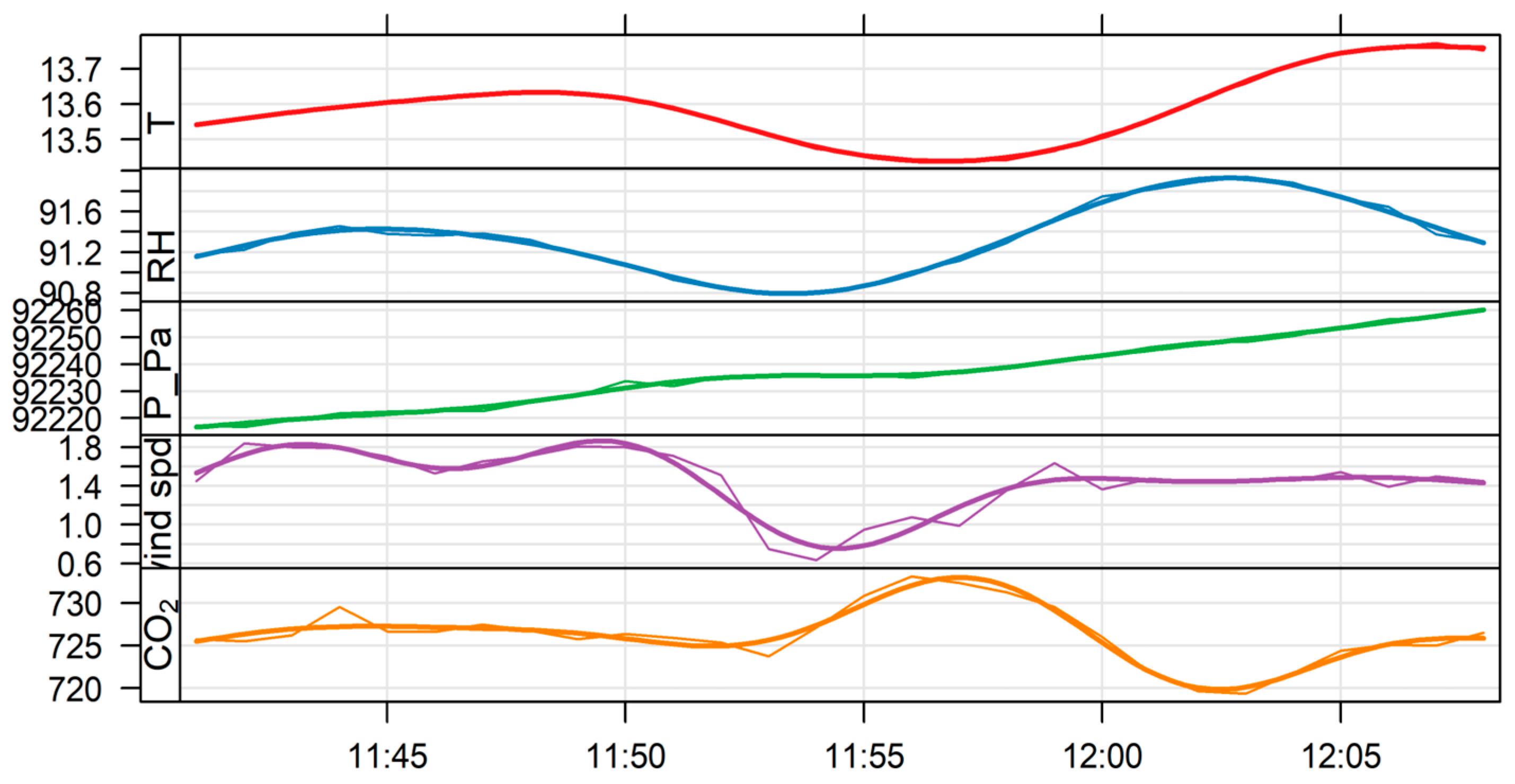





| Parameter | Sensors | Measuring Range | Accuracy |
|---|---|---|---|
| Carbon dioxide | MSP | 0 ÷ 5.000 ppm | ±30 ppm |
| Temperature | MSP | −40 ÷ 70 °C | ±(0.4 °C + 0.023 × (T [°C] − 25 °C)) |
| Relative humidity | MSP | 0 ÷ 100% RH | ±3% RH |
| Pressure | MSP | 300 ÷ 1.100 hPa | ±1 hPa |
| Wind speed | U | 1 ÷ 25 m ∙ s−1 | ±0.3 m ∙ s−1 at 10 m ∙ s−1 |
| Wind direction | U | 0 ÷ 359 °N | ±1 °N |
| Temperature | Temperature/RH Data Logger | −40 ÷ 70 °C | ±0.2 °C from 0 to 70 °C |
| Relative humidity | Temperature/RH Data Logger | 0 ÷ 100% RH | ±3% RH |
| MSP 1 (Upwind) | MSP 2 (Downwind) | ||||||||||
|---|---|---|---|---|---|---|---|---|---|---|---|
| Day | Date (dd/mm/yy) | Time | Time After Tilling (min.) | Temp. (°C) | Press. (Pa) | CO2 (ppm) | Temp. (°C) | Press. (Pa) | CO2 (ppm) | WS (m ∙ s−1) | WD (° from N) |
| 1 | 10 May 2024 | 06:56 | 23 | 13.14 H1 | 92,257.79 | 586.21 | 13.57 H2 | 92,228.27 | 727.13 | 1.49 | 270.95 |
| 2 | 13 May 2024 | 07:15 | 25 | 12.35 H3 | 92,121.86 | 598.56 | 13.20 H1 | 92,434.90 | 732.77 | 1.14 | 305.35 |
| 3 | 14 May 2024 | 07:15 | 21 | 10.59 H1 | 92,150.12 | 595.48 | 11.48 H2 | 92,131.36 | 665.19 | 1.65 | 309.29 |
| 4 | 15 May 2024 | 06:39 | 5 | 12.92 H3 | 92,193.65 | 556.63 | 13.71 H2 | 92,162.73 | 672.28 | 1.50 | 281.62 |
| 5 | 16 May 2024 | 07:15 | 15 | 14.66 H3 | 92,943.47 | 547.54 | 15.68 H1 | 92,219.53 | 654.41 | 1.38 | 245.89 |
| 6 | 17 May 2024 | 06:56 | 27 | 13.13 H3 | 92,770.82 | 598.13 | 13.13 H2 | 92,446.23 | 675.35 | 1.59 | 272.66 |
| 7 | 21 May 2024 | 07:15 | 14 | 13.12 H2 | 92,513.28 | 555.58 | 14.13 H1 | 92,485.73 | 650.01 | 1.36 | 286.02 |
| 8 | 28 May 2024 | 07:38 | 23 | 15.71 H1 | 92,376.23 | 605.28 | 15.98 H2 | 92,371.84 | 743.08 | 1.83 | 232.44 |
| Day | Class F | Class B | Difference |
|---|---|---|---|
| 1 | 0.021 | 0.041 | −0.020 |
| 2 | 0.054 | 0.045 | 0.009 |
| 3 | 0.050 | 0.037 | 0.013 |
| 4 | 0.018 | 0.034 | −0.016 |
| 5 | 0.046 | 0.042 | 0.004 |
| 6 | 0.012 | 0.024 | −0.012 |
| 7 | 0.015 | 0.026 | −0.011 |
| 8 | 0.134 | 0.100 | 0.034 |
| RMSE (ppm) | |||||||
|---|---|---|---|---|---|---|---|
| Day 1 | Day 2 | Day 3 | Day 4 | Day 5 | Day 6 | Day 7 | Day 8 |
| 46.62 | 74.42 | 97.83 | 275.12 | 61.92 | 104.74 | 80.40 | 77.44 |
Disclaimer/Publisher’s Note: The statements, opinions and data contained in all publications are solely those of the individual author(s) and contributor(s) and not of MDPI and/or the editor(s). MDPI and/or the editor(s) disclaim responsibility for any injury to people or property resulting from any ideas, methods, instructions or products referred to in the content. |
© 2025 by the authors. Licensee MDPI, Basel, Switzerland. This article is an open access article distributed under the terms and conditions of the Creative Commons Attribution (CC BY) license (https://creativecommons.org/licenses/by/4.0/).
Share and Cite
Mattia, A.; Becciolini, V.; Conti, L.; Merlini, M.; Ferraz, P.F.P.; Ferraz, G.A.e.S.; Ferreira, J.C.; de Oliveira, F.M.; Rossi, G. A UAV-Based System for Validating a Backward Lagrangian Stochastic Model in a Dairy Cattle Farm. Sensors 2025, 25, 6733. https://doi.org/10.3390/s25216733
Mattia A, Becciolini V, Conti L, Merlini M, Ferraz PFP, Ferraz GAeS, Ferreira JC, de Oliveira FM, Rossi G. A UAV-Based System for Validating a Backward Lagrangian Stochastic Model in a Dairy Cattle Farm. Sensors. 2025; 25(21):6733. https://doi.org/10.3390/s25216733
Chicago/Turabian StyleMattia, Alessio, Valentina Becciolini, Leonardo Conti, Marco Merlini, Patricia Ferreira Ponciano Ferraz, Gabriel Araújo e Silva Ferraz, Jacqueline Cardoso Ferreira, Franck Morais de Oliveira, and Giuseppe Rossi. 2025. "A UAV-Based System for Validating a Backward Lagrangian Stochastic Model in a Dairy Cattle Farm" Sensors 25, no. 21: 6733. https://doi.org/10.3390/s25216733
APA StyleMattia, A., Becciolini, V., Conti, L., Merlini, M., Ferraz, P. F. P., Ferraz, G. A. e. S., Ferreira, J. C., de Oliveira, F. M., & Rossi, G. (2025). A UAV-Based System for Validating a Backward Lagrangian Stochastic Model in a Dairy Cattle Farm. Sensors, 25(21), 6733. https://doi.org/10.3390/s25216733









